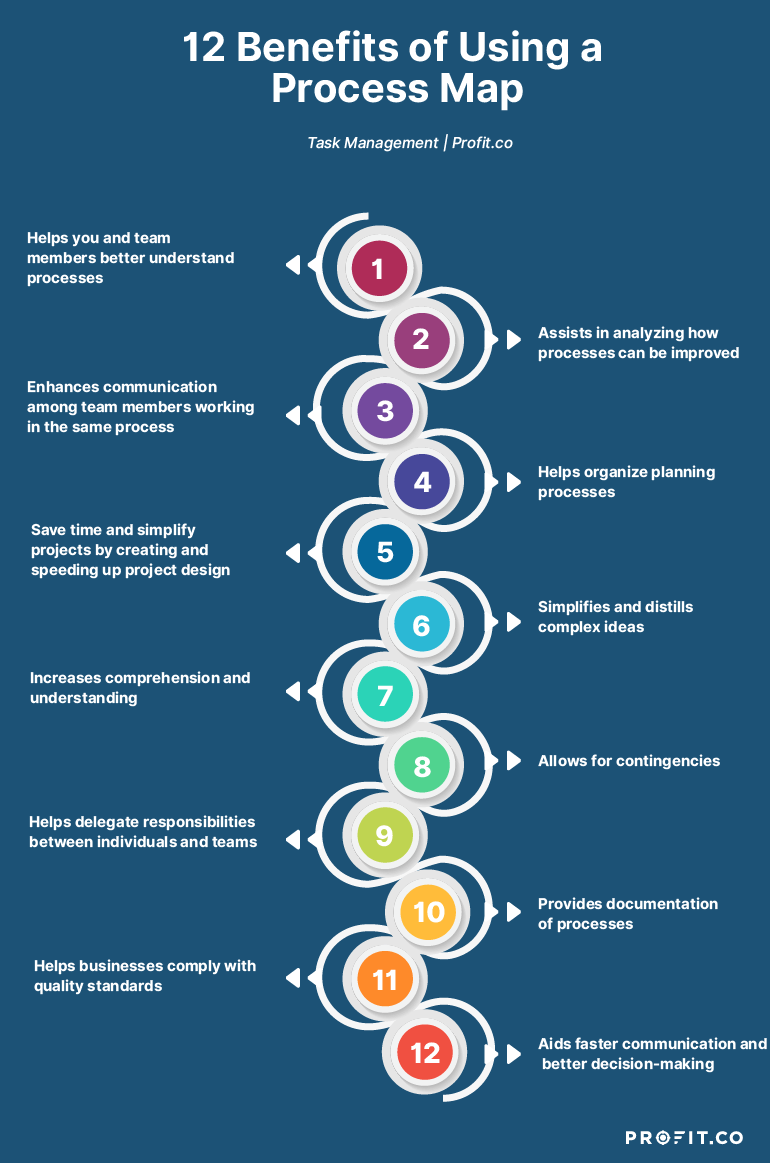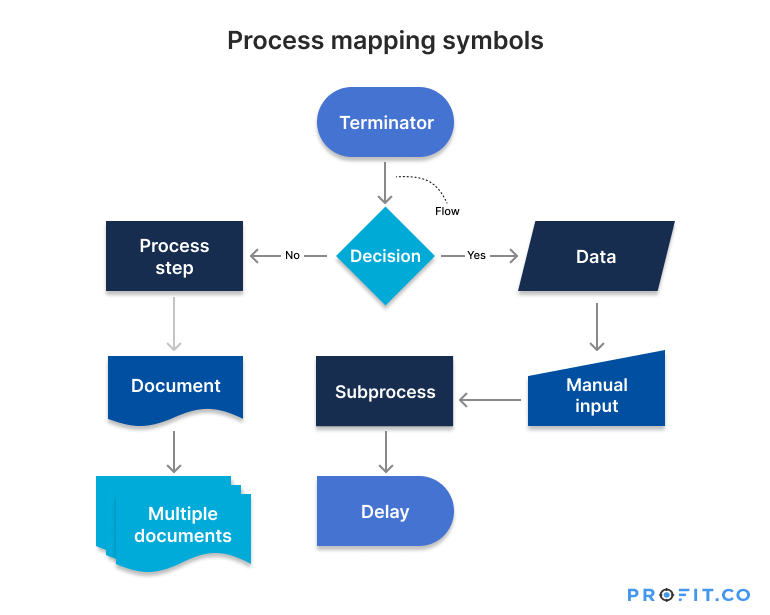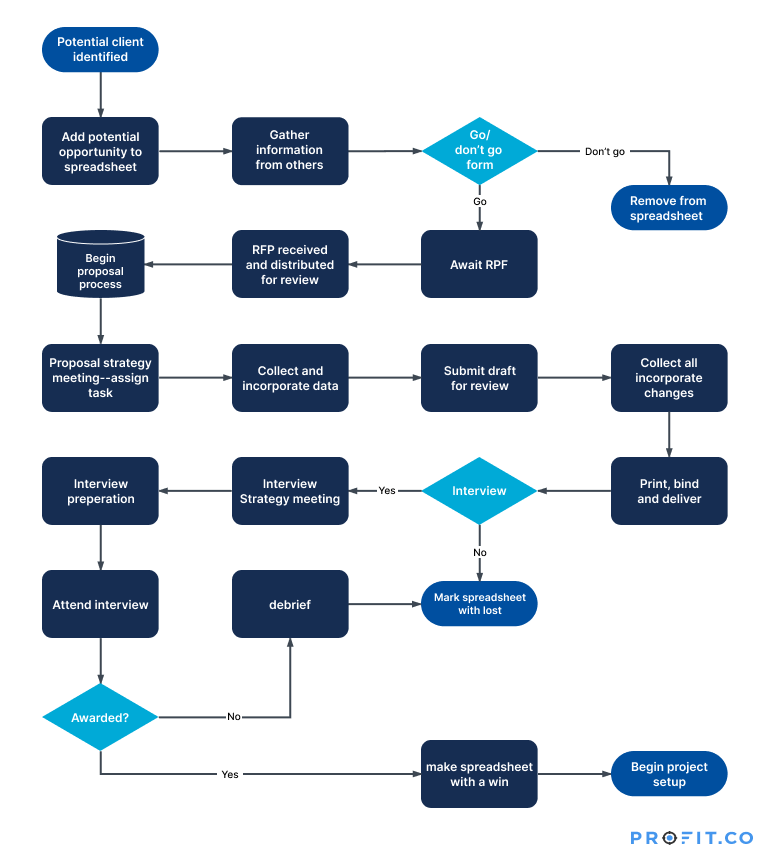What Is Process Mapping? A Guide to Process Mapping With Sample Template
Process mapping allows you to understand how a particular process works. This is a diagram map of workflow, including all business process steps.
Understanding Process Mapping
Process mapping is a technology involving the mapping of workflows and processes. The result of process mapping is a process map. You may also refer to process maps as workflow diagrams, flow charts, or process flowcharts.
The goal of process mapping is to convey how a process operates. Process mapping has to be concise and straightforward. It enables team members to understand how to accomplish a procedure without the need for lengthy explanations.
If you can’t describe what you are doing as a process, you don’t know what you’re doing.
You can develop a greater understanding of the working of a process by mapping it out from beginning to end. Mapping allows you to identify deficiencies and make improvements.
Process mapping can encapsulate any process. Its common uses include analyzing processes, tutoring, integration, and betterment. Additionally, process mapping helps communicate complex processes and solve recurring problems within a process, and it also coordinates the responsibilities of various teams. This way, priorities for different teams are all strategically aligned towards a common goal.
Why Do Businesses Need It?
A process is a collection of interconnected tasks that need to take place to fulfill a certain business function. These tasks provide the customer with the desired outcome. A company can use process mapping for:
- Business process improvement
- Business process redesign
- Quality improvement
- Documentation
- Reengineering
- Process analysis
- Training
- Process integration
- Quality improvement
- Acquisitions, simulation
- Information technology
- Management of work
- Operational process design
- Mergers
- Selling the company’s operations
Business process mapping can also aid compliance with manufacturing and service industry regulatory requirements.
Benefits of Process Mapping
Process mapping can highlight areas where resources are being wasted and enhance the work processes already in place in your business. It can also improve the process comprehension of your entire team.
Process mapping is different from writing comprehensive instructions. It visually communicates essential functions without too much literature. Process maps assist you in comprehending the key features of a process.
When your team comprehends a process better, it helps them generate valuable data for problem-solving. Process maps will enable you to ask tactical questions that will help you enhance any process. Process maps also:
- Helps you and team members better understand processes
- Assists in analyzing how processes can be improved
- Enhances communication among team members working in the same process
- Helps organize planning processes
- Save time and simplify projects by creating and speeding up project design
- Simplifies and distills complex ideas
- Increases comprehension and understanding
- Allows for contingencies
- Helps delegate responsibilities between individuals and teams
- Provides documentation of processes
- Helps businesses comply with quality standards
- Aids faster communication and better decision-making

Types of Process Maps
There are various types of process maps. These include:
- Basic flowcharts: are diagrams that show the essential elements of a process, including inputs and outputs. Businesses use them to plan new projects, and model and document strategies. They also solve problems, help communicate and manage ideas, and can assist in analyzing different workflows.
- Cross-functional flowcharts: These are also known as deployment maps. They show the relationships between various teams.
- Deployment maps: These use swimlane diagrams. The diagrams identify redundancies and bottlenecks in a company’s processes. They also identify process failures, delays, rework, and excessive inspection.
- Detailed process maps: These contain many sub-processes to show elaborate versions of a process. They document a processes’ decision points and detail the inputs and outputs of a process.
- High-level process maps: These are also known as top-down maps or value chain maps. They detail the macro view of different processes. According to IBM, they include vital processes such as supplier, input, process, output, or customer (SIPOC). High-level process maps define specific business processes and identify the steps and details of a process.
- Rendered process maps: These represent current and or possible future processes. They highlight areas for improvement of processes.
- A value stream map (VSM): A VSM documents all steps necessary to develop a product or service from start to finish.
Project management techniques like process mapping can be combined with other business and goal management frameworks to achieve the best results for your business. OKRs and project management go hand-in-hand, as OKRs help define measurable outcomes you can track in order to determine if your high-priority goals are being achieved.
Profit.co’s OKR management software can help you focus on your most important goals, measure your progress, and achieve more, more efficiently. You can get started on Profit.co free for thirty days!
Process Mapping in 5 Steps
Process maps are simple to create, and can be made using paper, software, or templates. Let’s walk through the steps involved in process mapping.
1. Identify the strategy you want to map
You have to decide on the starting point. You should ask yourself the process you need to map and name it.
The process could be underperforming processes or a process necessary for your business strategy, and they could also be customer satisfaction-related processes. Business priorities should be the basis of choosing what procedure needs mapping.
2. Assemble the right team
You should gather individuals with a solid understanding of the process in question. They should have the necessary expertise in the identified process. According to IBM, experts can help you pinpoint critical information in the process that one person might not be able to think of alone.
Such information might include resources needed, key stakeholders, the timeline, or simply the sequence of steps you need to follow. Including everyone in the process allows you to cover all process aspects during mapping. Experts can also point out some issues, such as constraints and redundancies, which could jeopardize efficiency. You should record all pertinent information about the process at this point in the process.
3. Outline the process map
Ascertain where the existing process begins and ends and the series of steps involved during this stage. While the attention to detail varies, typically, you should include information about metrics, inputs, stakeholders, outputs, and metrics.
To improve the sequence map, use standard flowchart symbols. Using basic flowchart symbols, optimize the existing process map. To complete this step, most people use process mapping applications and software.
4. Get feedback
Verify the improved process map with your team members to ensure the accuracy of the process documentation. Validation of the process with your team eliminates repetition and catches any details that were overlooked.
Begin soliciting input on possible process optimizations once stakeholders have consented to the process steps in their current state. Process validation may entail removing steps for simplicity or adding others to allow for increased cooperation or quality control and assurance.
5. Implement and observe changes
You should implement and monitor all adjustments to the process. Before scaling up any changes throughout the organization, undertake a proof of concept (POC) with a subcategory of the team.
This reduces the business risk and allows for the incorporation of additional reviews to improve the process. As a result, it will enable the management to transition smoothly to a new process at scale. Monitor the processes regularly, allowing for constant improvements.
Process Mapping Symbols
Process mapping uses Unified Modeling Language (UML) symbols to represent key elements of a map. These include steps, decision points, inputs and outputs, and participating team members.
The most common signs include:
- Ovals: Also called terminators. They represent the start and end of a process.
- Rectangles: Represents tasks and activities
- Arrows (flow): Show direction flow as well as connecting steps
- Diamonds: Illustrate decision points. Yes and no options branch at this point
- D Shape: This signifies a delay in the process
- Rectangle with a wavy bottom line: Represents readable documents or information Multiple stacked wavy rectangles represent numerous documents.
- Parallelogram: Represents process maps’ input or output data.
- Rectangle with a slanted top line: Represents the step requiring manual data entry
- Rectangle with double vertical lines: Indicates a subprocess predefined elsewhere

A Business Process Map Template
It is crucial to maintain consistency as your business expands. This implies that everybody on your team understands best practices, and team members must follow a standard business process model for consistency and efficiency.
Below is an example courtesy of Lucid Chart:

Process mapping is an excellent technique that can help you and your team iron out and understand complex processes with ease. Combined with an agile OKR management tool, your strategy execution can become more efficient than ever.
To learn more about how Profit.co can help you connect your processes and projects to your high-level company goals, book a free demo with our experts today!

